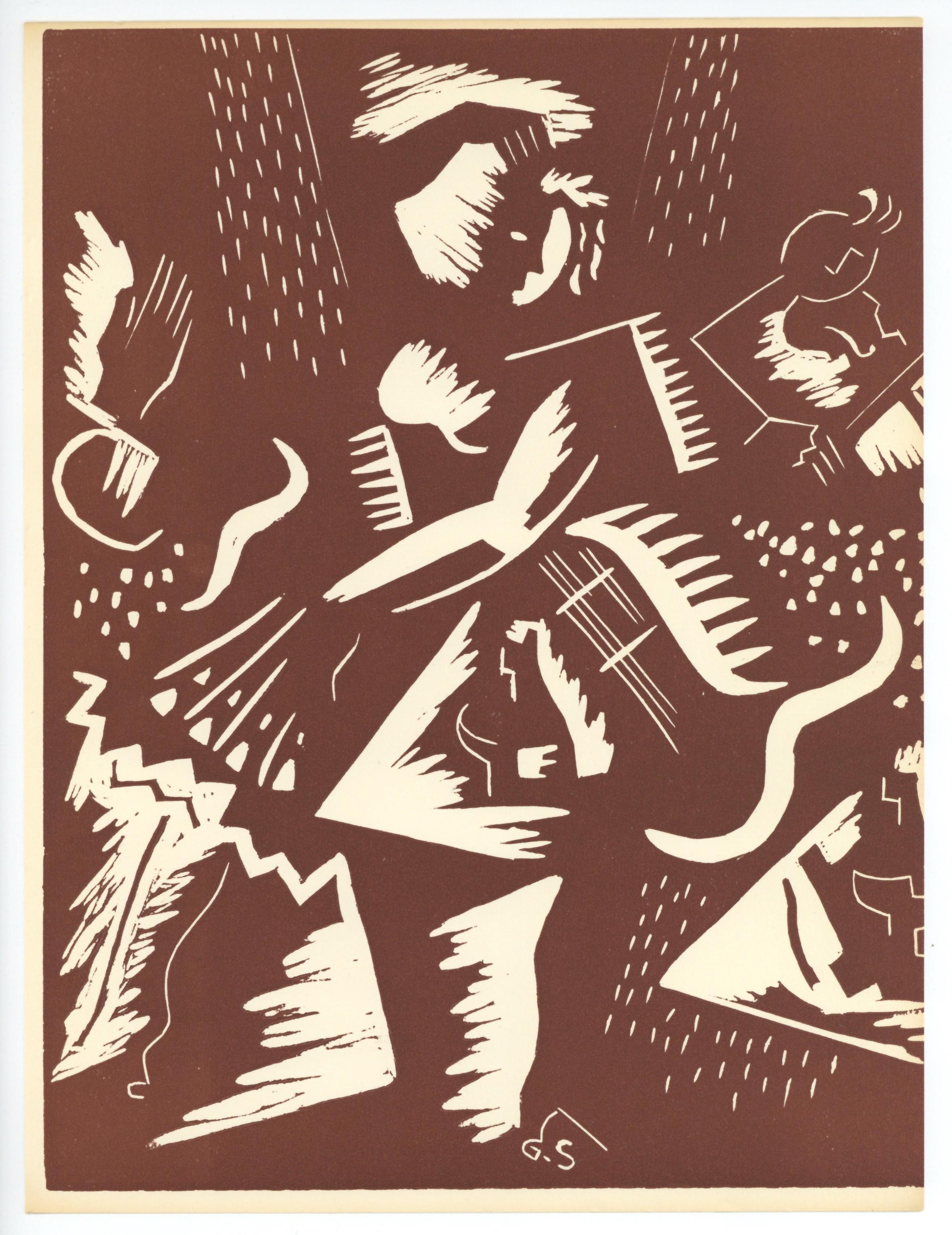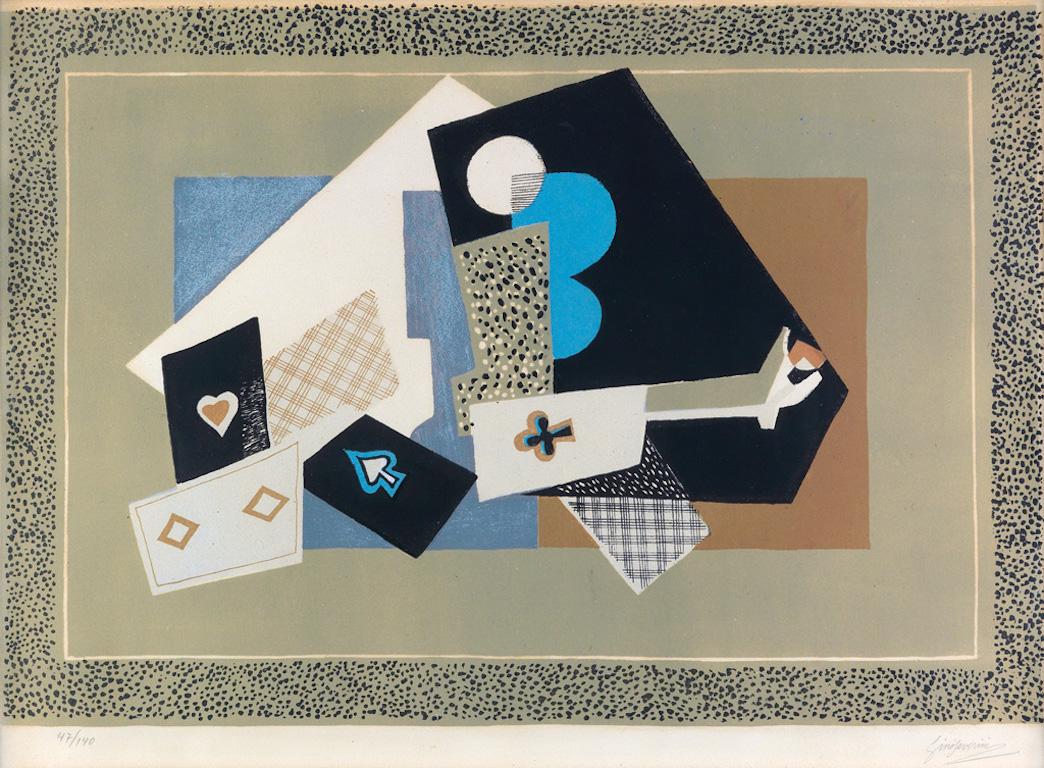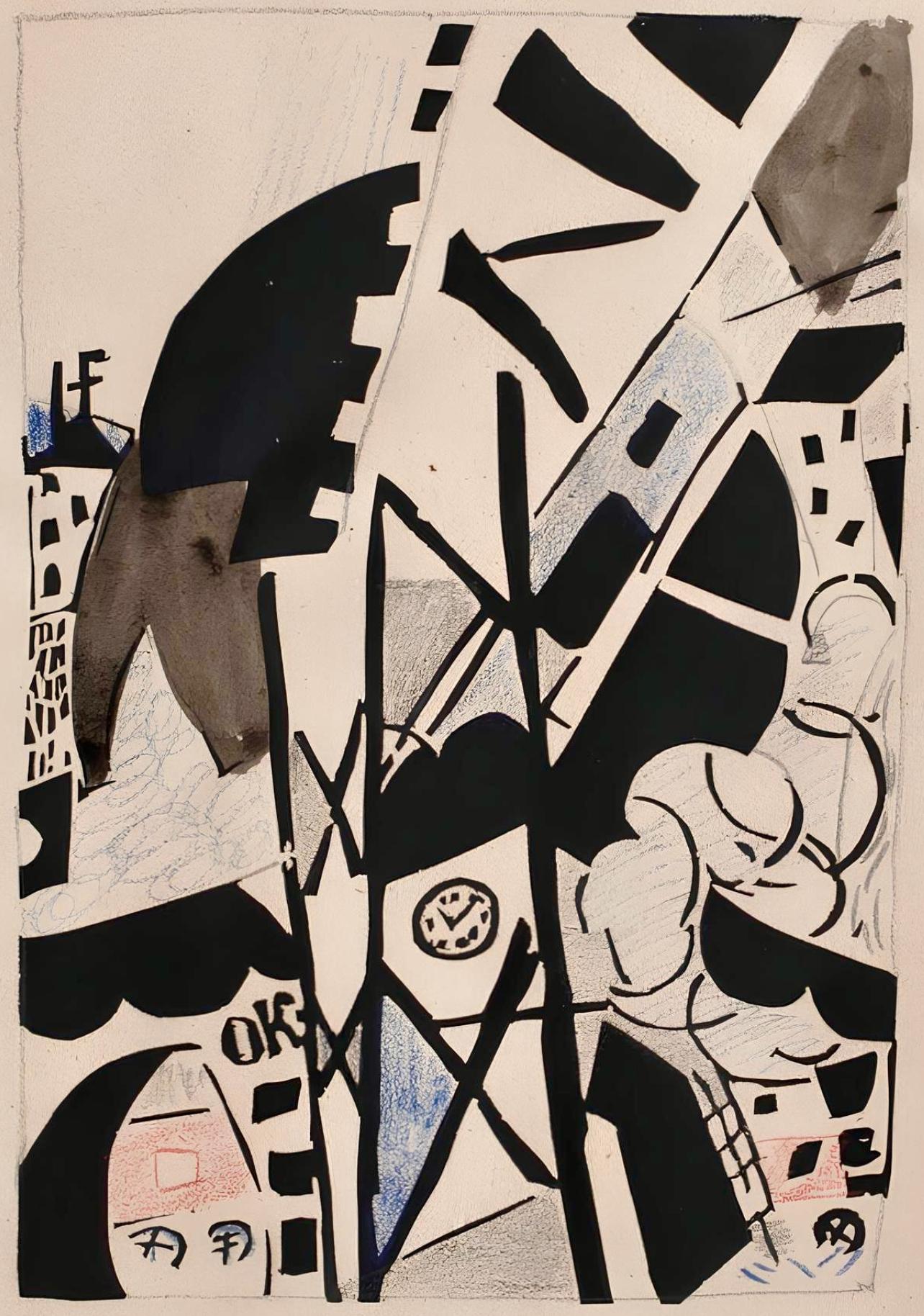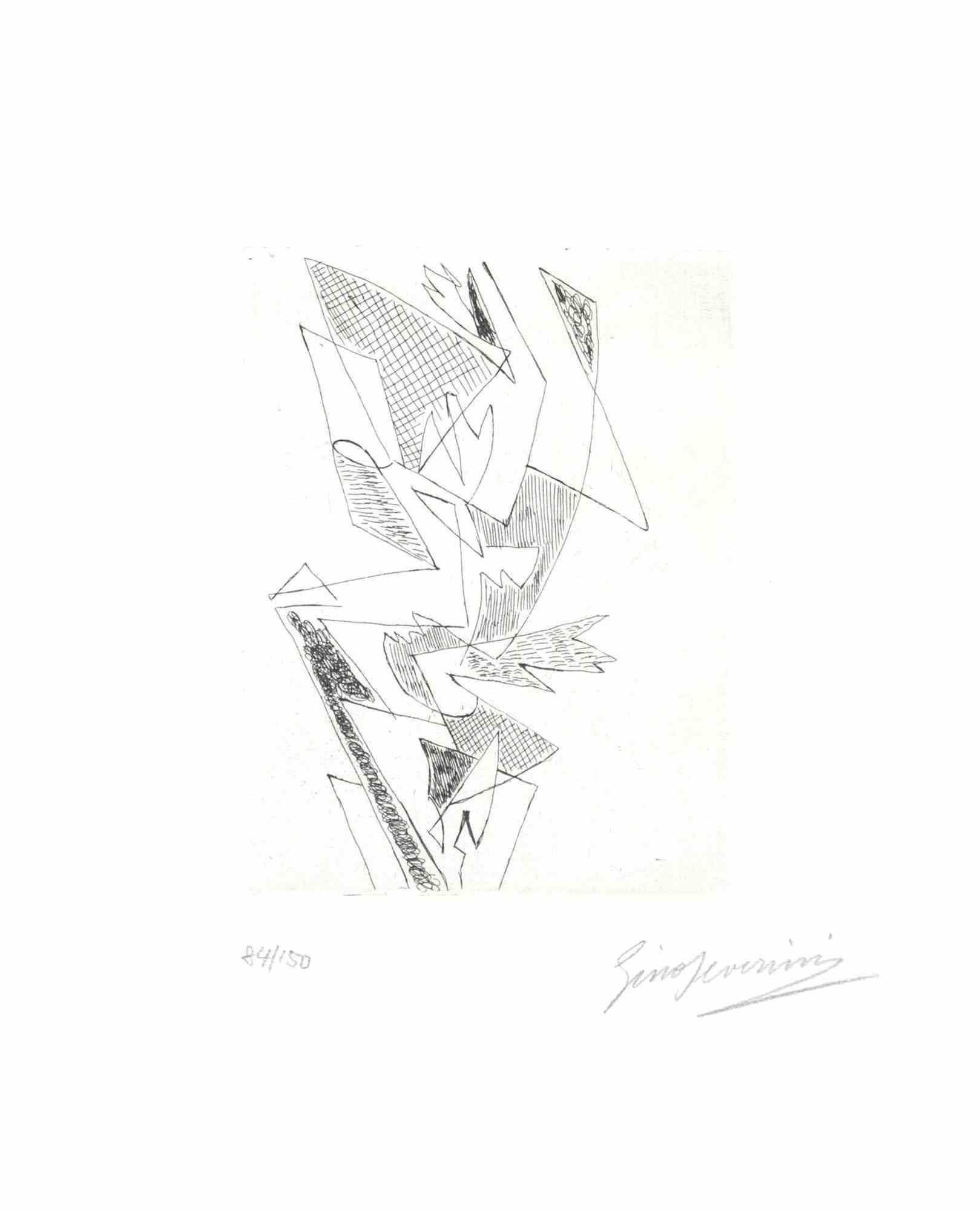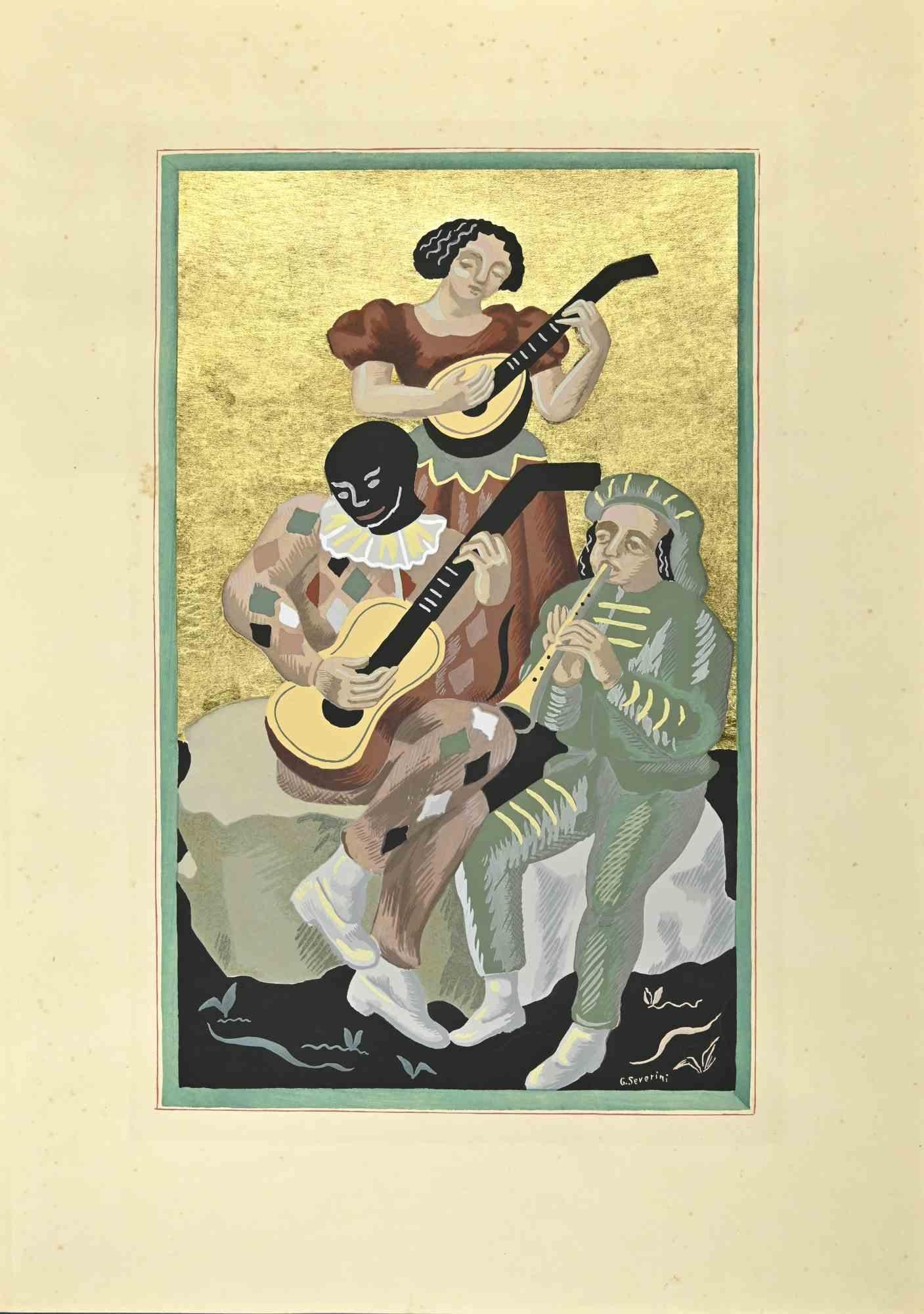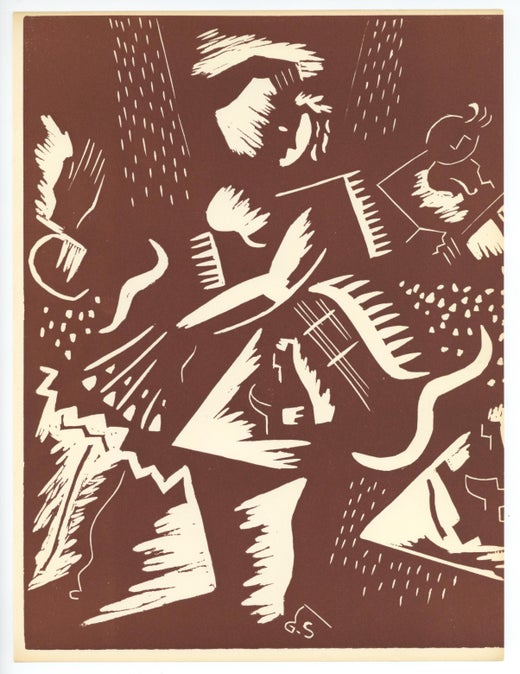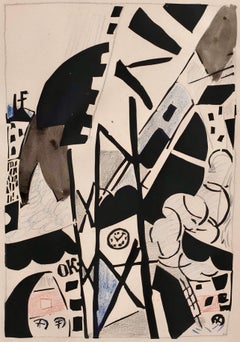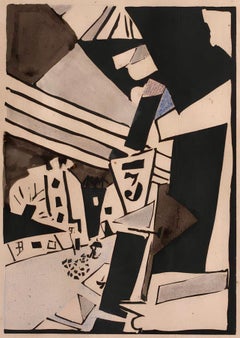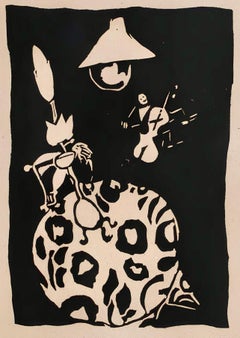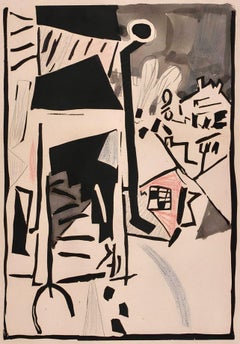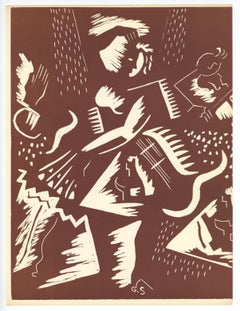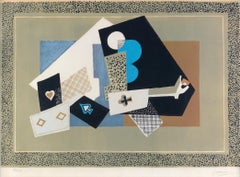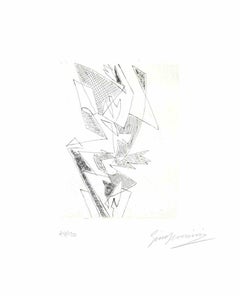Items Similar to Gravure futuriste (Meloni 20), Société internationale d'art XXe siècle
Want more images or videos?
Request additional images or videos from the seller
1 of 6
Gino SeveriniGravure futuriste (Meloni 20), Société internationale d'art XXe siècle1939
1939
$956
$1,19520% Off
£721.88
£902.3520% Off
€831.89
€1,039.8620% Off
CA$1,349.32
CA$1,686.6520% Off
A$1,487.60
A$1,859.5020% Off
CHF 778.26
CHF 972.8320% Off
MX$18,250.05
MX$22,812.5720% Off
NOK 9,796.79
NOK 12,245.9820% Off
SEK 9,161.54
SEK 11,451.9320% Off
DKK 6,212.59
DKK 7,765.7320% Off
About the Item
Linocut on vélin paper. Paper Size: 12.4 x 9.65 inches. Inscription: Signed in the plate and unnumbered, as issued. Catalogue raisonné references: Meloni, Francesco, and Gino Severini. Gino Severini: Tutta L’opera Grafica. Libreria Prandi, 1982, illustration 20. Notes: From the album, XXe siècle, Chroniques du jour, 13 rue Valette (5e), Directeur G. di San Lazzaro, Sommaire du n°5/6, 1939. Published and printed by Gualtieri di San Lazzaro, éditeur, Paris, in collaboration with Société Internationale d'Art XXe siècle, Paris, 1939. Additional notes: Excerpted from the academic article, “Promoting Original Prints, The Role of Gualtieri di San Lazzaro and XXe Siècle” by Valerie Holman, published in Print Quarterly, XXXIII, 2016, 2, Until recently very little has been written on the Italian author and art publisher Gualtieri di San Lazzaro (1904-75), yet for 50 years he chronicled the life and work of contemporary artists, produced monographs of exceptional quality, and disseminated original prints by modern painters and sculptors through his best-known periodical, XXe Siècle. Although still a relatively unfamiliar figure in the United Kingdom, San Lazzaro is one of the half-dozen great art publishers of the mid-twentieth century who, together with his exemplar, Ambroise Vollard (1866-1939), and those of his own generation, Christian Zervos (1889-1970), Tériade (1889-1983) and Albert Skira (1904-73), chose to base himself in Paris, seeing it throughout his life as the centre of the art world….XXe Siècle, an illustrated periodical, was launched in 1938 and printed in editions of approximately 2,000, each issue containing both photographs and four-colour separation reproductions across a wide spectrum of visual imagery ranging from masterpieces of Western painting to popular prints from the Far East. Its large format, lively design, and close integration of text and image, were immediately striking, but its most innovative feature, introduced at the suggestion of Hans Arp (1886-1966), was the inclusion of original prints by contemporary artists in every issue. With obvious appeal for collectors, XXe Siècle was also designed to introduce a wider, international public to contemporary painting and sculpture through good quality colour reproductions and the immediacy of original prints. Comparable in price to Cahiers d'Art, early issues of XXe Siècle sold out rapidly. While San Lazzaro's own aesthetic preferences tended towards lyric abstraction, he made clear that XXe Siècle was non-partisan [publication ceased during World War II]….in 1951, San Lazzaro relaunched XXe Siècle with thematic issues that were materials based, or centred on a topic of current interest in the visual arts, particularly in Europe: concepts of space, matter, monochrome, mark-making and the sign.' A defining feature of the new series was Italy's artistic dialogue with France for, while San Laz-zaro had originally concentrated on Paris-based painters and sculptors, his aim was to create an international network, to make known the work of French artists in Italy and Italian artists in France, and subsequently extend this bilateral axis to the English-speak-ing world. The artists represented in No. I by an original print were all best known as sculptors: Arp, Laurens, Henry Moore (1898-186) and Marino Marini, San Lazzaro not only sought to show readers the full range of an artist's work, but to encourage the production of prints, a stimulus much appreciated, for example, by Magnelli…. Suffering from failing health, in 1968 San Lazzaro lost overall control of XXe Siècle to Léon Amiel, a printer-publisher who had provided financial backing and helped with distribution in America." Thematic issues now ceased and were replaced by a 'panorama' of the year, but San Lazzaro was still active as a publisher of books and albums of prints….Shortly after his death, San Lazzaro himself was the subject of two exhibitions: 'Omaggio a XXe Siècle' in Milan in December 1974 centred on graphic work by those artists closest to him late in life, while 'San Laz-zaro et ses Amis' at the Musée d'Art Moderne de la Ville de Paris in 1975 featured work by all those whose work he had promoted for more than 50 years: Arp, Calder (1898-1976), Capogrossi, Chagall, Sonia Delau-nay, Dubuffet, Estève, Lucio Fontana (1899-1968), Gili-oli (1911-77), Magnelli, Marini, Miró, Moore and Poliakoff. This exhibition was seen by one of his closest colleagues as an indirect portrait of San Lazzaro, a complex man whose modesty and reserve masked his unremitting drive to extend international appreciation of contemporary art, and to bring the reading public closer to its making through the medium of print.
GINO SEVERINI (1883-1966) was an Italian painter and a leading member of the Futurist movement. For much of his life he divided his time between Paris and Rome. Severini was associated with neo-classicism and the "return to order" in the decade after the First World War. During his career he worked in a variety of media, including mosaic and fresco. He showed his work at major exhibitions, including the Rome Quadrennial, and won art prizes from major institutions. He studied at the Scuola Tecnica in Cortona before moving to Rome in 1899. There he attended art classes at the Villa Medici and by 1901 met Umberto Boccioni, who had also recently arrived in Rome and later would be one of the theoreticians of Futurism. Together, Severini and Boccioni visited the studio of Giacomo Balla, where they were introduced to painting with “divided” rather than mixed color. After settling in Paris in November 1906, Severini studied Impressionist painting and met the Neo-Impressionist Paul Signac. Severini soon came to know most of the Parisian avant-garde, including Georges Braque, Juan Gris, Amedeo Modigliani, and Pablo Picasso; Lugné-Poë and his theatrical circle; the poets Guillaume Apollinaire, Paul Fort, and Max Jacob; and author Jules Romains. After joining the Futurist movement at the invitation of Filippo Tommaso Marinetti and Boccioni, Severini signed the Manifesto tecnico della pittura futurista of April 1910, along with Balla, Boccioni, Carlo Carrà, and Luigi Russolo. However, Severini was less attracted to the subject of the machine than his fellow Futurists and frequently chose the form of the dancer to express Futurist theories of dynamism in art. Severini helped organize the first Futurist exhibition at Galerie Bernheim-Jeune, Paris, in February 1912, and participated in subsequent Futurist shows in Europe and the United States. In 1913, he had solo exhibitions at the Marlborough Gallery, London, and Der Sturm, Berlin. During the Futurist period, Severini acted as an important link between artists in France and Italy. After his last truly Futurist works—a series of paintings on war themes—Severini painted in a Synthetic Cubist mode, and by 1920 he was applying theories of classical balance based on the Golden Section to figurative subjects from the traditional commedia dell’arte. He divided his time between Paris and Rome after 1920. He explored fresco and mosaic techniques and executed murals in various mediums in Switzerland, France, and Italy during the 1920s. In the 1950s, he returned to the subjects of his Futurist years: dancers, light, and movement. Throughout his career, Severini published important theoretical essays and books on art. In 2008, Gino Severini's painting, Danseuse, sold for $20,171,648 USD at Christie's, setting a world record for the artist.
- Creator:Gino Severini (1883-1966, Italian)
- Creation Year:1939
- Dimensions:Height: 12.4 in (31.5 cm)Width: 9.65 in (24.52 cm)
- Medium:
- Movement & Style:
- Period:
- Condition:
- Gallery Location:Southampton, NY
- Reference Number:1stDibs: LU1465216660542
Gino Severini
Gino Severini (7 April 1883 – 26 February 1966) was an Italian painter and a leading member of the Futurist movement. For much of his life he divided his time between Paris and Rome. He was associated with neo-classicism and the "return to order" in the decade after the First World War. During his career he worked in a variety of media, including mosaic and fresco. He showed his work at major exhibitions, including the Rome Quadrennial, and won art prizes from major institutions.
About the Seller
4.9
Platinum Seller
Premium sellers with a 4.7+ rating and 24-hour response times
Established in 1978
1stDibs seller since 2021
1,179 sales on 1stDibs
Typical response time: <1 hour
- ShippingRetrieving quote...Shipping from: Southampton, NY
- Return Policy
Authenticity Guarantee
In the unlikely event there’s an issue with an item’s authenticity, contact us within 1 year for a full refund. DetailsMoney-Back Guarantee
If your item is not as described, is damaged in transit, or does not arrive, contact us within 7 days for a full refund. Details24-Hour Cancellation
You have a 24-hour grace period in which to reconsider your purchase, with no questions asked.Vetted Professional Sellers
Our world-class sellers must adhere to strict standards for service and quality, maintaining the integrity of our listings.Price-Match Guarantee
If you find that a seller listed the same item for a lower price elsewhere, we’ll match it.Trusted Global Delivery
Our best-in-class carrier network provides specialized shipping options worldwide, including custom delivery.More From This Seller
View AllPougny, Composition, Pougny, dix linogravures originales, 1914-1920 (after)
By Jean Pougny
Located in Southampton, NY
Linocut on vélin vergé ancien paper. Unsigned and unnumbered, as issued. Good condition. Notes: From the folio, Pougny, dix linogravures originales, 1964. Published by Au Vent d'Arle...
Category
1960s Cubist Abstract Prints
Materials
Linocut
$4,076 Sale Price
20% Off
Free Shipping
Pougny, Composition, Pougny, dix linogravures originales, 1914-1920 (after)
By Jean Pougny
Located in Southampton, NY
Linocut on vélin vergé ancien paper. Unsigned and unnumbered, as issued. Good condition. Notes: From the folio, Pougny, dix linogravures originales, 1964. Published by Au Vent d'Arle...
Category
1960s Cubist Abstract Prints
Materials
Linocut
$4,076 Sale Price
20% Off
Free Shipping
Pougny, Composition, Pougny, dix linogravures originales, 1914-1920 (after)
By Jean Pougny
Located in Southampton, NY
Linocut on vélin vergé ancien paper. Unsigned and unnumbered, as issued. Good condition. Notes: From the folio, Pougny, dix linogravures originales, 1964. Published by Au Vent d'Arle...
Category
1960s Cubist Abstract Prints
Materials
Linocut
$4,076 Sale Price
20% Off
Free Shipping
Pougny, Composition, Pougny, dix linogravures originales, 1914-1920 (after)
By Jean Pougny
Located in Southampton, NY
Linocut on vélin vergé ancien paper. Unsigned and unnumbered, as issued. Good condition. Notes: From the folio, Pougny, dix linogravures originales, 1964. Published by Au Vent d'Arle...
Category
1960s Cubist Abstract Prints
Materials
Linocut
$4,076 Sale Price
20% Off
Free Shipping
Pougny, Composition, Pougny, dix linogravures originales, 1914-1920 (after)
By Jean Pougny
Located in Southampton, NY
Linocut on vélin vergé ancien paper. Unsigned and unnumbered, as issued. Good condition. Notes: From the folio, Pougny, dix linogravures originales, 1964. Published by Au Vent d'Arle...
Category
1960s Cubist Abstract Prints
Materials
Linocut
$4,076 Sale Price
20% Off
Free Shipping
Pougny, Composition, Pougny, dix linogravures originales, 1914-1920 (after)
By Jean Pougny
Located in Southampton, NY
Linocut on vélin vergé ancien paper. Unsigned and unnumbered, as issued. Good condition. Notes: From the folio, Pougny, dix linogravures originales, 1964. Published by Au Vent d'Arle...
Category
1960s Cubist Abstract Prints
Materials
Linocut
$4,076 Sale Price
20% Off
Free Shipping
You May Also Like
original linocut
By Gino Severini
Located in Henderson, NV
Medium: original linoleum cut. This linocut by Italian Futurist Gino Severini was printed in 1939 for the art revue XXe Siecle and published in Paris by San Lazzaro. Size: 12 1/2 x 9...
Category
1930s Futurist Prints and Multiples
Materials
Linocut
Gino Severini (1883 - 1966) - Danseuse - Seven-color lithograph - 1957
By Gino Severini
Located in Varese, IT
Seven-color lithograph , edited in 1957
Limited edition of 175 copies , numbered 83/175 in lower left
Hand signed by artist in pencil in the lower right margin
paper size: : 66.2 x 5...
Category
1950s Abstract Prints and Multiples
Materials
Lithograph
Nature Morte
By Gino Severini
Located in New York, NY
A very good impression of this color lithograph with strong colors. Signed and numbered 119/140 in pencil by Severini. Printed by Michael Cassé, Paris. Published by L'Œuvre Gravée, P...
Category
1950s Futurist Abstract Prints
Materials
Color, Lithograph
Black Composition - Etching by Gino Severini - 1962
By Gino Severini
Located in Roma, IT
Black composition is an artwork realized by Gino Severini, (Cortona, Italy 1883 - 1966 Paris) in 1962.
50x40 sheet, 15x11 image; etching on paper, es. 84/150.
Hand signed lower ri...
Category
1960s Futurist Abstract Prints
Materials
Etching
Les Mans d'Arlequin - Pochoir by Gino Severini - 1930
By Gino Severini
Located in Roma, IT
Les Amans d'Arlequin is an artwork realized by Gino Severini in 1930.
Pochoir from the Suite "Fleurs et Masques".
Very good condition.
Signed in plate on the lower right.
Ref. Ca...
Category
1930s Futurist Figurative Prints
Materials
Paper, Stencil
Still Life with Violin Natura Morta con Violino - Cubism Italian Futurism
By Gino Severini
Located in London, GB
This original lithograph in colours is hand signed in pencil by the artist "Gino Severini" in the lower right margin and signed in the plate "Severini" in the lower right corner of t...
Category
1960s Futurist Still-life Prints
Materials
Lithograph
More Ways To Browse
G Albert
G Ses
Henry Link Vintage
Robert Indiana Indiana In Lewiston
Shiy De Jinn
Shlomo Cassos
Signed And Numbered Miro
Stella Michaels
Sunny Kai
Tajima Hiroyuki
The Paris Review Print
Tinguely Poster
Triptychs Of Water
Twombly Sarajevo
Victor Brauner Poster
Victor Vasarely Vega
Vintage Bazooka
Vintage Horse Blinders
